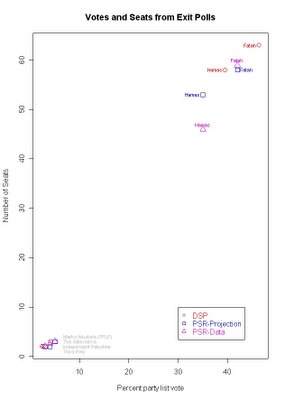
(Click on the figure for a larger image.)
There were three exit polls done for the Palestinian Legislative Council elections on January 25th, one by the Development Studies Programme at Bir Zeit University, another by the Palestinian Center for Policy and Survey Research (PSR) and the third poll was done by An-Najah University in Nablus.
The results for the party list ballot were:
DSP/Bir Zeit: Fatah 46.4%, Hamas 39.5%
PSR: Fatah 42%, Hamas 35%
An-Najah: Fatah 46%, Hamas 40%
Both DSP and PSR have posted reports of their results to their websites. PSR has produced two, somewhat contradictory, sets of results. They offer a summary paragraph of results (which I call "PSR-Projection" in the graph above) and a detailed list of estimated results (which I call "PSR-Data" above. DSP has produced a PowerPoint summary of their results. So far, I have not been able to find a detailed set of results for the An-Najah exit poll, so I can say nothing more about it here.
The graph above presents the estimates from the DSP and PSR exit polls, separating the PSR "Projections" and "Data". Estimates of Hamas seats range from 46 to 58. Estimates of Fatah seats range from 58 to 63. These estimates combine the national party list allocation of 66 seats by proportional representation with the 66 multi-member district seats, for a total of 132 seats.
The "PSR-Data" estimates that Fatah will win 28 PR seats plus 31 district seats, for a total of 59. Hamas is estimated to get 23 PR and 23 districts seats, for a total of 46. In the PSR calculations, 8 seats remain undecided and 4 district seats have been won by independents. Other parties control a total of 9-10 seats in this estimate.
There are some problems with the "PSR-Data" estimates, however. They total only 127 seats, leaving 5 seats unaccounted for.
The summary paragraph in PSR's web page, which I call "PSR-Projection", manages to total 132 seats, but has some mystery of its own. The "PSR-Projection" has Fatah winning 58 seats (one less than their "data" suggest), and Hamas winning 53, an unaccounted for gain of 7 seats from the "data". There are still 8 seats undecided in this calculation, but the five missing seats plus one previously awarded to Fatah appear to have been shifted to Hamas, plus one more from a small party (apparently "The Alternative"). There may be a good reason for these shifts, but it is not explained on the PSR website as of 23:03 CST (7:03 Thursday Ramallah time).
The DSP estimates, on the other hand, leave no ambiguity. DSP estimates Fatah winning 63 seats, and Hamas 58. Independents win two district seats, and four small parties share 9 seats.
And so, we have a range of estimated seats as well as votes. And some irony. While PSR is less than clear about its calculations that don't quite add up, DSP is apparently absolutely certain of its seat distribution. DSP leaves no seats undecided and does not suggest a range of possible outcomes for any party. Consistency is very nice, but an apparent lack of uncertainty is less convincing in its own way than PSR's inconsistency that at least partially acknowledges uncertainty of some outcomes.
Hence the graph above presents all three estimates. That directly reminds us that none of these estimates are certain and that the variability is large enough to be politically significant. Based on these estimates, it seems unlikely that Fatah will command a majority of seats. Whether they can form a majority coalition is unclear to me, as it depends on the choices of the smaller parties and the independents (not to mention the undecided seats.) What does seem justified to conclude is that Fatah has fallen short of its bid for a majority and that this will have ramifications for whichever government forms.
One other important finding from the DSP exit poll: 71% of voters thought the election was fair, 26 percent thought it was somewhat fair and only 3.5% said it was unfair. I take that as a good sign for the legitimacy of the election regardless of the final seat distribution.
And a comment on the exit polls themselves. In the US we don't have the luxury of comparing three exit polls anymore. Cost constraints have pushed the major news organizations to create the National Election Pool which conducts a single exit poll for all news media to feed from. So it is especially satisfying that the Palestinians have managed to conduct three (3!) exit polls under conditions that are infinitely more trying and with resources which are orders of magnitude less than what the NEP has to work with. I'm sure that there are problems with the DSP, PSR and An-Najah polls as with any exit poll, and we've seen here their variability and the problems of inconsistency (PSR) and too much certainty (DSP). But I'd like to take my hat off for a moment to appreciate the enormous effort that these three survey organizations have taken to provide scientific and (I believe) unbiased estimates of the outcomes of these crucial elections.
For all the problems the Palestinians face, I think these three organizations are a tribute to the effort to build and support democratic institutions. We should all be grateful for that effort.